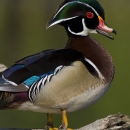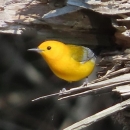Seasons of Wildlife
Spring
In early spring, wildflowers appear on the hillsides. Dogwood and redbud trees burst into full bloom after a few warm days. Turkeys can be heard attempting to attract their mates. Hibernating snakes emerge from the bluffs and travel back to the swamp. Watch for the migrating snakes on the roads.
Later in the spring songbirds and wading birds flock to the marshes and bottomland forests of the refuge. Young bald eagles can be seen flapping their wings on the edge of the nests in preparation for their first flight.
Summer
During the summer months look for wood duck broods as they learn how to swim on the refuge ditches. Great blue herons and great egrets congregate in shallow pools and fields. Turtles are often seen crossing the roads in search of mates and nesting areas.
Fawns with their mothers can be seen grazing and frolicking. The open fields along Bluff Road are opportune places to catch a glimpse. The best time to view wildlife in the summer heat is early in the morning or just before dusk in the evening.
Fall
Fall colors erupt on the refuge. Bright oranges, vibrant yellows and all the shades of glimmering gold highlight the hills and swamps of the refuge. Even though bald cypress trees are coniferous, they too will lose their leaves after turning fiery red.
Fall also marks the time of the migration. The snakes start moving back up to the bluffs to hibernate during the cold winter months. Neo-tropical migrants will move through the refuge on their way back to their wintering grounds in South America. In late fall the waterfowl and eagles start arriving on the refuge in search of food.
Winter
Birds are everywhere on the refuge during the winter months. Waterfowl are here to stay over the cold months or migrating through to warmer places. Moist soil units are ready to serve the hungry ducks and geese. The refuge is an all-you-can-eat smorgasbord!
The refuge serves as a wintering ground for bald eagles and concentrations of eagles are readily observed. Every two years, the refuge celebrates Bald Eagle Days.
Featured Species
The habitat at Mingo National Wildlife Refuge provides resources for a large variety of common and rare animals and has served as a site for supporting threatened and endangered species. A total of 279 resident and migratory bird species, 38 mammal species, 30 species of amphibian and reptiles and nearly 50 species of fish use the refuge throughout the year.







